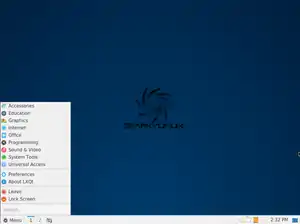SparkyLinux
SparkyLinux is a desktop-oriented operating system based on the Debian operating system. The project offers a ready to use operating system with a set of various customised lightweight desktops to choose from.[5]
 | |
 SparkyLinux 5 "Nibiru" LXQt | |
| Developer | SparkyLinux team[1] |
|---|---|
| OS family | Linux (Unix-like) |
| Working state | Current |
| Source model | Open source |
| Initial release | 5 May 2012[2] |
| Latest release | (Rolling release) / Installation DVD SparkyLinux 5.14 "Nibiru"[3] / 5 October 2020 SparkyLinux 4.13[4] |
| Available in | Multilingual |
| Update method | APT (front-ends available) |
| Package manager | dpkg (front-ends available) |
| Platforms | IA-32, x86-64, ARM |
| Kernel type | Monolithic (Linux) |
| Userland | GNU |
| Default user interface | LXQt, MATE and Xfce |
| License | Mainly GPL and other free software licenses, minor additions of proprietary |
| Official website | sparkylinux |
History
The project was born on October, 2011 as an Ubuntu remix with Enlightenment as the default desktop having the name ue17r (Ubuntu Enlightenment17 Remix). After a few months of testing, the base system has been changed to Debian and it was renamed to SparkyLinux.
Features
SparkyLinux is based on "stable" and "testing" branch of Debian and uses 'rolling-release-cycle' (testing based only). It includes a collection of tools and scripts to help users with easy administration of the system.[6]
The default desktop environments are LXQt (former LXDE), MATE and Xfce but users can install other desktops via 'Sparky APTus'.
As Sparky iso image features a few proprietary packages, the 'Sparky APTus' provides a small tool called 'Non-Free Remover' which can easily uninstall all 'contrib' and 'non-free' packages from the system.
Special Editions
- GameOver Edition, targeted to gamers. It features a large set of free and open-source games and some needed tools;
- Rescue Edition, provides a live system and a large number of applications for recovering broken operating systems;
- Multimedia for audio, video and html pages creating;
- MinimalCLI and MinimalGUI.[6]
Releases
SparkyLinux is released 3-4 times per year to provide the latest versions of all applications.
| Colour | Meaning |
|---|---|
| Red | Release no longer supported |
| Green | Release still supported |
| Blue | Future release |
| Release | Name | Date | Release notes |
|---|---|---|---|
| 1.0 | Venus | 2012-05-05 | SparkyLinux 1.0[2] |
| 2.0 | Eris | 2012-10-12 | SparkyLinux 2.0[7] |
| 3.0 | Annagerman | 2013-07-27 | SparkyLinux 3.0[8] |
| 4.0 | Tyche | 2015-06-26 | SparkyLinux 4.0[9] |
| 4.1 | 2015-10-02 | SparkyLinux 4.1[10] | |
| 4.2 | 2015-12-21 | SparkyLinux 4.2[11] | |
| 4.3 | 2016-04-29 | SparkyLinux 4.3[12] | |
| 4.4 | 2016-08-20 | SparkyLinux 4.4[13] | |
| 4.5.2 | 2016-12-18 | SparkyLinux 4.5.2[14] | |
| 4.7 | 2017-11-18 | SparkyLinux 4.5.2[15] | |
| 4.8 | 2018-05-13 | SparkyLinux 4.5.2[15] | |
| 4.9 | 2018-11-11 | Sparky Linux 4.9[16] | |
| 4.11 | 2019-07-10 | Sparky Linux 4.11[17] | |
| 5.0 | Nibiru | 2017-07-16 | SparkyLinux 5.0[18] |
| 5.1 | 2017-09-27 | SparkyLinux 5.1[19] | |
| 5.2 | 2017-12-20 | SparkyLinux 5.2[20] | |
| 5.3 | 2018-03-10 | SparkyLinux 5.3[21] | |
| 5.4 | 2018-06-11 | SparkyLinux 5.3[22] | |
| 5.6.2 | 2018-12-07 | SparkyLinux 5.6.2[23] | |
| 5.7.1 | 2019-04-03 | SparkyLinux 5.7.1[3] | |
| 5.8 | 2019-07-17 | SparkyLinux 5.8[3] | |
| 5.9 | 2019-10-07 | SparkyLinux 5.9[3] | |
| 5.10.1 | 2020-02-05 | SparkyLinux 5.10.1[3] | |
| 5.11 | 2020-04-04 | SparkyLinux 5.11[24] | |
| 5.12 | 2020-07-07 | SparkyLinux 5.12[25] | |
| 5.13 | 2020-11-05 | SparkyLinux 5.13[26] | |
| 5.14 | 2021-02-04 | SparkyLinux 5.14[27] | |
| 6 | Po Tolo (Eng: Sirius B) | (Semi-)rolling | SparkyLinux 6 |
References
- "SparkyLinux Team".
- https://linuxiarze.pl/sparkylinux-1-final/
- "Sparky 5.14". 4 February 2021. Retrieved 4 February 2021.
- "Sparky 4.13". 5 October 2020. Retrieved 5 October 2020.
- https://sparkylinux.org/wiki/doku.php
- About SparkyLinux | SparkyLinux
- https://linuxiarze.pl/sparkylinux-2-0-eris/
- https://sparkylinux.org/sparkylinux-3-0/
- https://sparkylinux.org/sparkylinux-4-0/
- https://sparkylinux.org/sparkylinux-4-1/
- https://sparkylinux.org/sparkylinux-4-2/
- https://sparkylinux.org/sparkylinux-4-3-is-out/
- https://sparkylinux.org/sparkylinux-4-4-is-out/
- https://sparkylinux.org/sparkylinux-4-5-2/
- https://sparkylinux.org/sparkylinux-4-8/
- "Sparky 4.9 celebrates 100 years of Poland's Independence | SparkyLinux". sparkylinux.org. Retrieved 2018-11-13.
- https://sparkylinux.org/sparkylinux-4-11/
- https://sparkylinux.org/sparky-5-0/
- https://sparkylinux.org/sparky-5-1/
- https://sparkylinux.org/sparky-5-2/
- https://sparkylinux.org/sparky-5-3/
- https://sparkylinux.org/sparky-5-4/
- https://sparkylinux.org/sparky-4-9-2-5-6-2/
- https://sparkylinux.org/sparky-5-11/
- https://sparkylinux.org/sparky-5-12/
- https://sparkylinux.org/sparky-5-13/
- https://sparkylinux.org/sparky-5-14/
External links
- Articles
- http://www.zdnet.com/google-amp/article/hands-on-sparky-linux-5-powered-by-debian/
- An Everyday Linux User Review Of SparkyLinux Gameover Edition, Everyday Linux User, October 2014
- SparkyLinux 3.5, DistroWatch Weekly, Issue 581, 20 October 2014
- SparkyLinux 3.5 (E18) Review – Lightweight, Comes with Lots of Apps, But a Bit Buggy, Hectic Geek, 11 October 2014
- Reach Unlimited, Review Sept. 30, 2014
- SparkyLinux GameOver Is a Winning Work-Play Combo, LinuxInsider, 20 August 2014
- SparkyLinux 3.4 GameOver -- a Linux distro for gamers, BetaNews, 8 July 2014
- SparkyLinux 3.2 Xfce Review, The Navy Christian, February 2014
- SparkyLinux 3.1 LXDE - Archaic and modern, Dedoimedo, 30 December 2013
- Everyday Linux User review of SparkyLinux 3.1 Razor-Qt Edition, Everyday Linux User, 26 November 2013
- SparkyLinux 3.6, Heise.de, October 2013
- SparkyLinux 2.1: Debian Testing en cinco minutos, La Sombra Del Helicoptero, 15 April 2013
- Mit Desura und Steam vorinstalliert: SparkyLinux 2.1 “GameOver”, BITblokes, 28 March 2013
- First look at SparkyLinux 2.1 "Ultra" edition, DistroWatch Weekly, Issue 495, 18 February 2013
- Sparkylinux 2.1 “Ultra” Review: Lightweight, fast and elegant Openbox distro for low spec computers!, mylinuxexplore, 4 February 2013
- SparkyLinux à tester sans installer, jetestelinux.com, 1 February 2013
- Linux für Zocker: SparkyLinux 2.0.1 – Mit Desura- und Steam-Client, BITblokes, 20 December 2012
- Other
